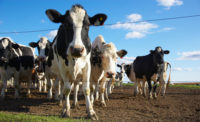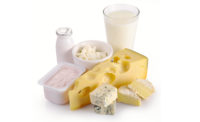IDDBA Study: Flavored Yogurts, Enhanced Milk Top Dairy Trends
Flavored yogurt and enhanced milk top dairy product trends, according to What’s in Store 2012, the annual trends report produced by IDDBA.
Flavored yogurt and enhanced milk top dairy product trends, according to What’s in Store 2012, the annual trends report produced by the International Dairy-Deli-Bakery Association (IDDBA), Madison, Wis.
Yogurt sales and consumption climb
Yogurt dollar sales rose 7% to $5.2 billion in the food/drug/mass channel in the 52-week period ending May 14, 2011, according to Nielsen. In 2010, Americans ate yogurt 7.5 times per month on average, up from 7 times per month in 2006, Mintel reported.
Yogurt brands continue to expand their varieties, particularly in the Greek yogurt section. Greek yogurt smoothies, new fruity flavors and yogurt can be substitutes for sour cream, mayonnaise and cream cheese in recipes. Cappuccino yogurt with almond crisp, orange yogurt with sea buckthorn, maple and strawberry rhubarb, for example, are some of the newer flavors.
Craft yogurts are also trendy in the dairy case. Since 2005, 30% of new product launches in the category have been craft products, which tout their milk sources and traditional processes, Specialty Food Magazine reported. Many feature milk from grass-fed cows, local flavorings or alternative milks, including sheep’s milk and goat milk, as well as artisanal yogurt in reusable glass or ceramic containers.
Enhanced milk offers more for all age groups
Enhanced milk is one of the new offerings in the dairy case that offers consumers more health options. Aside from vitamin milk concocted with special blends to cater to kids, teens and women, there are also milk blends of cows’ milk and nut milks. Kids can get milk in flexible ‘squeezy pouches’ with screw tops that make it fun to drink, as well as flavored varieties with less sugar and fewer calories. Protein-rich milk with added vitamins are popular, as are meal-replacement shakes and sleep-provoking beverages that contain milk, soy, valerian root extract and melatonin.
Milk tops the list of food purchased most often because of an added benefit or fortification.
Better-for-you and better-for-the environment are top dairy trends as consumers lean toward products with natural nutritional properties, functional additives and sustainably produced actions. Dairy products make up 14.6% of organic food sales, second to the fruit and vegetable category, which commanded 39.7% of the market. Organic dairy product sales rose by 9% in 2010 to $3.9 billion in 2010, according to the Organic Trade Association, Brattleboro, Vt.
Euromonitor, London, projects the U.S. dairy market will grow to $53 million by 2015, up 5.2% from 2010.
U.S. dairy consumption rises
The most recent data shows U.S. dairy product consumption rose to 607.1 pounds per capita in 2009 from 603.7pounds in 2008, according to the U.S. Department of Agriculture, Washington, D.C. Consumer units, typically defined as households, spent $409 annually on dairy products, the most recent data (2009) show. This decrease of 4.9% from the year before comes amid an across-the-board consumer spending decline.
Household penetration for dairy products is 99.6%, with milk and cheese topping the list at 97% and 96.9% respectively, Chicago-based Perishables Group found. Consumers average 34.8 dairy department shopping trips per year. More than half of these shopping trips include multiple items from the dairy case.
For more information, or to order the What’s in Store 2012 study, go to www.iddba.org.
Flavored yogurt and enhanced milk top dairy product trends, according to What’s in Store 2012, the annual trends report produced by the International Dairy-Deli-Bakery Association (IDDBA), Madison, Wis.
Yogurt sales and consumption climb
Yogurt dollar sales rose 7% to $5.2 billion in the food/drug/mass channel in the 52-week period ending May 14, 2011, according to Nielsen. In 2010, Americans ate yogurt 7.5 times per month on average, up from 7 times per month in 2006, Mintel reported.
Yogurt brands continue to expand their varieties, particularly in the Greek yogurt section. Greek yogurt smoothies, new fruity flavors and yogurt can be substitutes for sour cream, mayonnaise and cream cheese in recipes. Cappuccino yogurt with almond crisp, orange yogurt with sea buckthorn, maple and strawberry rhubarb, for example, are some of the newer flavors.
Craft yogurts are also trendy in the dairy case. Since 2005, 30% of new product launches in the category have been craft products, which tout their milk sources and traditional processes, Specialty Food Magazine reported. Many feature milk from grass-fed cows, local flavorings or alternative milks, including sheep’s milk and goat milk, as well as artisanal yogurt in reusable glass or ceramic containers.
Enhanced milk offers more for all age groups
Enhanced milk is one of the new offerings in the dairy case that offers consumers more health options. Aside from vitamin milk concocted with special blends to cater to kids, teens and women, there are also milk blends of cows’ milk and nut milks. Kids can get milk in flexible ‘squeezy pouches’ with screw tops that make it fun to drink, as well as flavored varieties with less sugar and fewer calories. Protein-rich milk with added vitamins are popular, as are meal-replacement shakes and sleep-provoking beverages that contain milk, soy, valerian root extract and melatonin.
Milk tops the list of food purchased most often because of an added benefit or fortification.
Better-for-you and better-for-the environment are top dairy trends as consumers lean toward products with natural nutritional properties, functional additives and sustainably produced actions. Dairy products make up 14.6% of organic food sales, second to the fruit and vegetable category, which commanded 39.7% of the market. Organic dairy product sales rose by 9% in 2010 to $3.9 billion in 2010, according to the Organic Trade Association, Brattleboro, Vt.
Euromonitor, London, projects the U.S. dairy market will grow to $53 million by 2015, up 5.2% from 2010.
U.S. dairy consumption rises
The most recent data shows U.S. dairy product consumption rose to 607.1 pounds per capita in 2009 from 603.7pounds in 2008, according to the U.S. Department of Agriculture, Washington, D.C. Consumer units, typically defined as households, spent $409 annually on dairy products, the most recent data (2009) show. This decrease of 4.9% from the year before comes amid an across-the-board consumer spending decline.
Household penetration for dairy products is 99.6%, with milk and cheese topping the list at 97% and 96.9% respectively, Chicago-based Perishables Group found. Consumers average 34.8 dairy department shopping trips per year. More than half of these shopping trips include multiple items from the dairy case.
For more information, or to order the What’s in Store 2012 study, go to www.iddba.org.
Looking for a reprint of this article?
From high-res PDFs to custom plaques, order your copy today!






